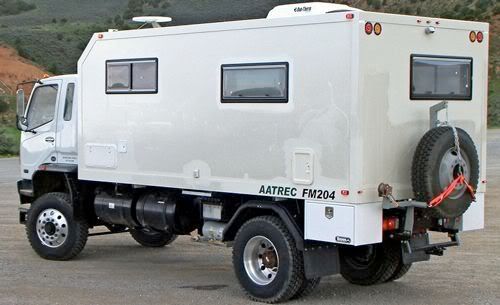In general, I think it really helps to go out and live in a camper for a month or two to build a list of practical requirements for a design before you begin one of these projects. Optimally, you'd do it overseas so you would have some experience with what the realities are outside the USA.
Based on living in our vehicle full time for 15 months out of the last 16, 8 of those overseas, I agree with Michel's assessment on the items he mentions, with the possible exception of window size. Assuming they are double or triple pane, the windows seem to be adequate based on eyeballing the photos.
Regarding his other comments:
- You DO NOT want to listen to a genset and an AC unit roar for hours on end. Lots of ventilation is a good idea and multiple roof vents are a requirement. I think one for the kitchen/dinette area, one for the bathroom and one for the berth would be a minimum. IMO they should all include fans.
- Security is a real issue, even given the "locks keep honest people out" rule. If you have your compartments locked people generally don't mess with them. Something that is open or easily opened invites trouble. IMO, every exterior access panel should/must be locked or closed with anti-tamper screws.
- Rock damage is a reality out here in the real world. If all you are going to do is drive down interstates from one pull-through-site campground to the next, no issue, but I doubt you'd buy one of these vehicles for that purpose. An area like Baja or Patagonia or your average chicken bus road will destroy anything not covered with a rock guard. Even a simple aluminum panel of decent guage will work, but you've got to cover things up on the underside of the vehicle.
- A screen door is a true no brainer. Anyone who has camped for more than a weekend would insist on one.
One thing I would add is the lack of an awning. Although Stephen Stewart recommends deleting them and I fully expected that every European rig would be without one, they are ubiquitous and heavily used outside of Patagonia where the winds preclude them. We use ours quite a bit and all the other overlanders I've spoken with do as well. They are worth the weight, especially on a chassis as heavy duty as the FM.
I would also change the spare tire to a European style under-chassis crank system. It is much cleaner, more secure and I think potentially easier to use.
For overseas use, I would fit a European tow bar and tow slots/hooks on each end of the vehicle. If I had it to do over again, I'd delete our winches and use this system.
One good feature of the design is a side door. A rear door is always covered with dirt. It adds work and time to stopping every night plus precludes carrying a bike or anything on the rear.
The upside to all of this is that apart from the widow size, all of these issues are relatively easy to retrofit or correct, even the vents.
Another upside is that in series production you can make changes as you go along.
In my experience Darrin is a very professional person, so I anticipate he will correct these issues in subsequent vehicles.










